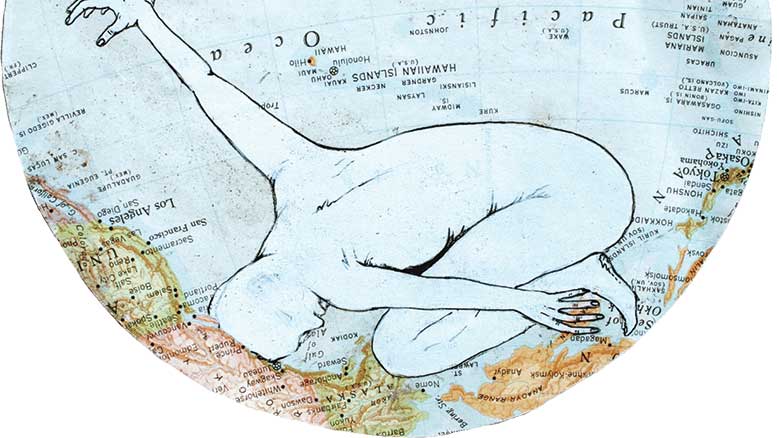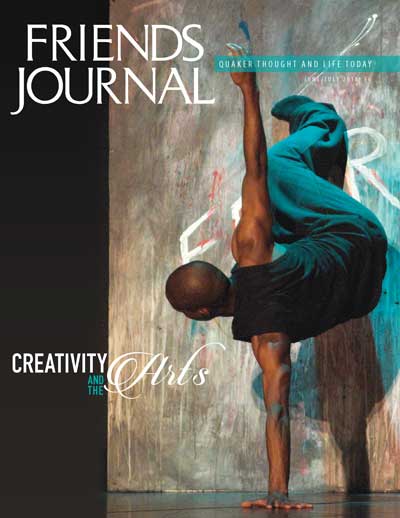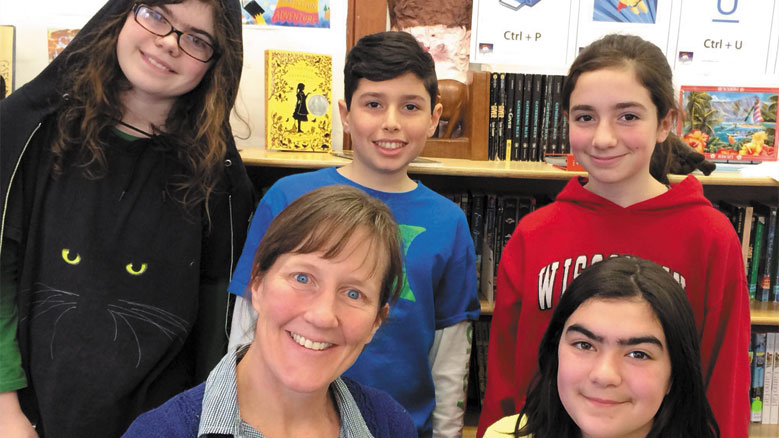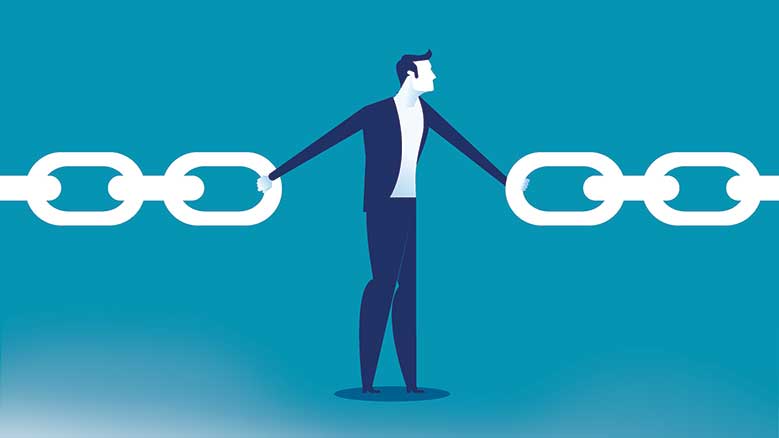
What do you want to be?
I guess the theme in my household growing up was education: two teacher parents and two diligent students. Many members of our Friends meeting were also teachers. I felt I was destined to become an educator. The more I learned about the world and the more inequality I saw, the more I wanted to “do something helpful.” Becoming a teacher seemed like an obvious path: I could influence scores of young minds every year. What an opportunity it would be to infiltrate the typical classroom with sneaky lessons about peace, integrity, stewardship, etc.
The ubiquitous childhood question of “what do you want to be?” has multiple choice answers in many kids’ books: firefighter, police officer, mail courier, doctor, mechanic. All of them seemed to be doing something explicitly helpful. Teaching made sense, too, with the added security of feeling familiar. But as I developed technical skills as an artist and manifested a creative mind and passionate spirit, those around me started commenting on my potential path as an artist. (If I had my eyes set on being a starving teacher in a capitalist society, I might as well be a starving artist, right?)
No thanks, I thought. Being an artist—I mean professionally—didn’t seem that helpful. I didn’t think I could have the kind of impact I thought was necessary to bring about significant change, especially in the context of the testimonies I was raised to value. I made it to college still pretty sure I would end up teaching, and in my first year I signed up for eight humanities courses and no art classes. I joined the environmental student group and starting thinking maybe some kind of nonprofit could be in the running, too.
By my sophomore year, however, I had somehow declared a double major of studio art and environmental justice. Five months after graduating, I found myself living in Philadelphia and making art. My business card said “human/artist.”
Quakerism has affected the way I see the world and what I feel is important to create.
It was at this point that I really thought about what it meant to be an artist, as a Quaker, as a resident of the United States and the earth, and as a human with an interest in peace and justice. I had to make some decisions. I felt a responsibility to take this dreamy profession and mold it into something valuable to the social justice community. The questions that kept coming back to me were: is art enough? and, am I doing the work the world needs? I struggled with these questions in my own privileged and Quaker way.
Another question I struggled with in a Quaker way was: how am I going to make enough money to survive, in the same weird world I’m trying to change? I started making illustrations of strange creatures with messages I wanted to send myself, and putting them on greeting cards, things like “Keep Going” and “Feed Love.” I networked a lot and, most importantly, I made new work constantly, even though I wasn’t happy with it. I gave myself a simple timeline: do this for five years, and then decide if you want to keep going.
Looking back at the last five years, I see several common threads winding through my work. Maps have shown up as my canvas, as well as an influence for my line work in ink; big questions about gender, race, equality, vulnerability, humanness, and relationships show up in small and big ways, even across different styles. Although I never consciously made work “as a Quaker,” it is undeniable that my Quakerism has affected the way I see the world and what I feel is important to create.
I would love for people to feel that Light, that connection to everything around them, even if it’s just a fleeting reminder.
Art changes people and people change the world
I learned early on that one of the hardest tasks in being an artist is pricing your work. This got easier, but at the beginning, it felt impossible to put a dollar number on a piece that I’d made. Apart from the hidden costs that most people don’t know about (not just materials but gallery cuts, studio space, vendor fees, etc.), artists are asked to measure the value of our time, experience, and creative power, not to mention, as a young artist, to keep the work affordable so that it can actually sell. Beyond that, I was still thinking about the societal value of my work in the world. There’s that voice again—who am I helping? Many times I felt like my art wasn’t enough, and that I should invest myself in teaching, social work, or another job that directly helps people. I didn’t have the energy or attitude to do art full-time on top of another full-time job, so it felt like I had to choose.
Two things grounded me. For the times when creating a piece of art felt too far away from healing the big issues, I reminded myself that art changes people and that people change the world. I remembered the times a song, image, film, poem, or performance stirred a feeling in me that brought me closer to myself and the world around me (my version of a connective spark that many refer to as the Light, the Spirit, or the Divine). If my work (the verb and the noun) can stir the Light in someone, who knows what great thing they might do with it?
I’m able to think critically about my practice as an artist through the lens of what I recognize as the Quaker testimonies.
For the times I feel like I’m making something just to make ends meet, I zoom out to the big picture. I look back at what I’ve made in the last few years and can see how my first year informed my second, my third informed my fourth, and so on. Even if one particular project doesn’t feel that meaningful in the moment, I know that I am working toward something bigger. I am constantly gaining experience that is bringing me toward where I want to be as an artist in the future. I don’t know what that looks like now, but maybe a connection I make now will open up an opportunity to help many people later. If there’s one thing that I’ve learned as a human/artist, it’s that everything is connected.
As someone who wants to live in a world where humans see each other and the world around us wholly and consciously, I realized that telling someone what to think is not generally effective. My intention is not for my art to explicitly answer anyone’s questions, but I hope to push viewers to ask their own questions based on what they feel. Ultimately, I would love for people to feel that Light, that connection to everything around them, even if it’s just a fleeting reminder. If I make work based on my own feelings around that, I just have to trust that it will translate organically.
The further I get on my journey, the more I’m able to expand my own understanding of my impact as an artist. So now, I’m not just thinking about the content of my pieces but what I use to make them, what I do with the money I make from my business, who I’m investing in when I buy what I need for my work, and how accessible my work really is. I’m able to think critically about my practice as an artist through the lens of what I recognize as the Quaker testimonies, and essentially challenge what is culturally normalized about racism, sexism, environmental justice, violence, and all forms of social injustice.
I’m constantly learning. Although I didn’t end up working in a school, I carry on and apply the most valuable lessons my favorite lifelong teachers ever taught me: keep asking questions, and be fair to yourself and others. As for my five-year check in, I asked myself how I feel about being an artist: how my daily activities relate to living my truth, what connections I’ve made, where I am financially, and where I see myself in another five years. I can’t imagine doing anything else.







Joey, in all of my interactions with you, you present as a role model. You’ve listened to your callings. You’ve reached out constantly to the world, both literally and figuratively, with your artwork. This week as I shopped for something to wear to an opening reception of my artwork, I thought of you among the racks of colorful clothing and remembered how you at one time shared with Young Friends that simple dress for you meant wearing grey. I stopped in my tracks and mentally inventoried what I already owned in my closet and decided to go home and make the best of it without any unnecessary purchases. Joey, you influence me still today! Congratulations on being published in Friends Journal. One of your map prints still hangs in the art room where I used to teach, even though I retired years ago. Your influence is being felt. Carry on.
I love these gender unspecific delicate figures embracing the planet or set against blue maps of the world. When astronauts see our planet from afar they also see a blue peaceful looking ball shape …Getting back to your paintings they bring instantaneous Peace to the mind and a feeling that humankind belongs on the planet as a whole and the planet and we are not separated..all is one.
Thank you for an interesting and inspiring article and works. I have posted a link to this on the British Quaker Arts Network Facebook page @quakerarts .
If you are not aware of this organisation, you may like to look at our website quakerart.net .
1.
The visual and auditory arts are part of what makes us human. We have evidence of ancient visual artistry from cave paintings; and musical instruments have been found that appear to be about 35,000 years old.
2.
We also have neuro-physiological evidence, at least for music.
I am not sure if similar studies have been done for the visual arts.
Based on EEG and neuro-imaging results, In right-handed humans, the left hemisphere of the brain usually becomes more activated by language, and the right-hemisphere becomes more activated by for visual art and music.
There is also evidence that for right-handed people who are musically skilled, musical activities engage the left hemisphere more fully: in other words, for some people who are musically proficient, music may processed in the brain as though it is another language.
3.
I am experienced at writing and playing music.
When I enter into silent worship, the messages that come to mind are not all verbal.
Some may be musical.
My thoughts echo what Malcolm Dalglish wrote in 1978, in Verse Four of his song “Shake these Bones:”
“I’ll tell you what I’m hearing Lord, all the time
I’m hearing songs and melodies in my mind
I’m hearing songs and melodies, but when they’re out of mind
We’ll hear the sweetest peace of all, left behind”
c. 1978 Tarquel Music, BMI
The complete lyrics are available here:
http://cindykallet.com/wp-content/uploads/2013/09/Shake-These-Bones.pdf
Several recordings of Shake These Bones by various artists have been uploaded to YouTube.
Brian Humphrey
Wilton Manors FL